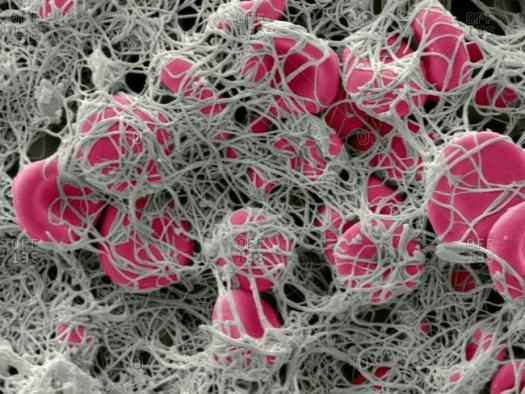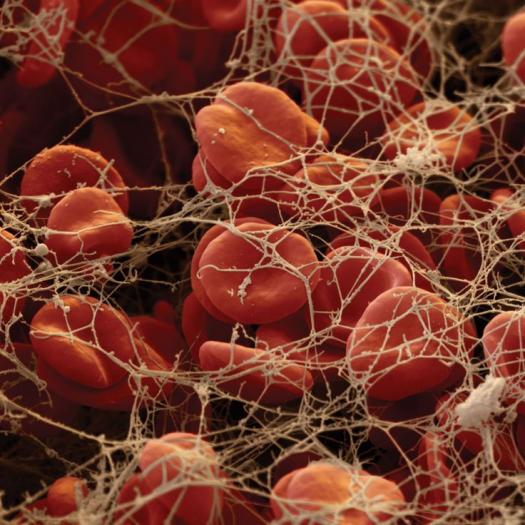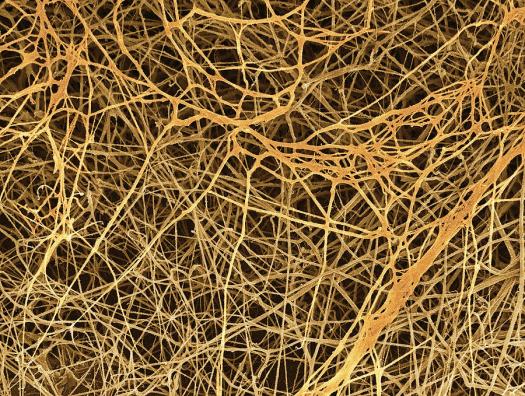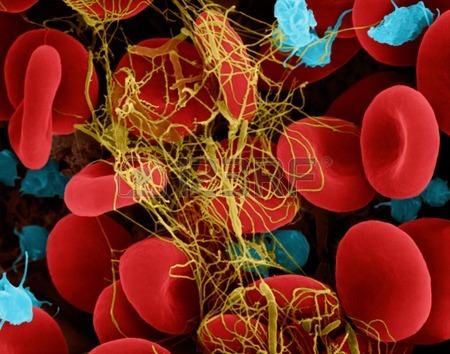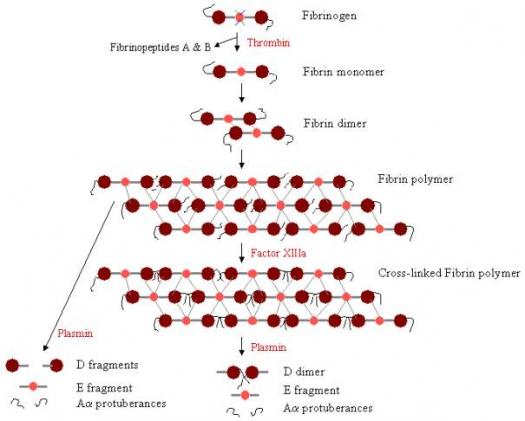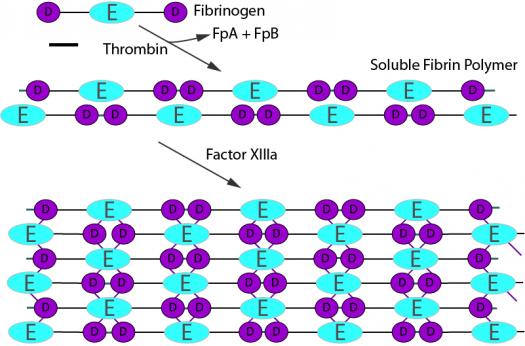Do You Know Fibrin?

Fibrin is an important substance involved in blood clotting. It is a fibrous, non-globular protein that can be obtained from animal sources and glycosylated with glycans.
- 1.
Fibrin is also called
- A.
Factor IA
- B.
Factor II
- C.
Factor III
- D.
Factor IV
Correct Answer
A. Factor IA -
- 2.
Fibrinogen is converted to fibrin by
- A.
Thrombin
- B.
Prothrombin
- C.
Fibrinase
- D.
Fibrogenase
Correct Answer
A. ThrombinExplanation
Thrombin is responsible for converting fibrinogen into fibrin. Thrombin is a key enzyme in the blood clotting process and plays a crucial role in the formation of a stable blood clot. When there is tissue damage or injury, thrombin is activated and converts fibrinogen, a soluble protein, into fibrin, which forms a mesh-like structure to trap platelets and form a clot. This conversion is essential for the clotting cascade to occur and prevent excessive bleeding.Rate this question:
-
- 3.
The activated fibrinogen is called
- A.
Fibrinogen monomer
- B.
Fibrin
- C.
Fibrin monomer
- D.
Fibrin polymer
Correct Answer
A. Fibrinogen monomerExplanation
Fibrinogen is a soluble protein that circulates in the blood. When there is an injury or damage to blood vessels, fibrinogen gets activated and converts into fibrin. Fibrinogen monomer refers to the individual units of fibrinogen, which are activated and undergo polymerization to form the fibrin polymer. Therefore, the activated form of fibrinogen is called fibrinogen monomer.Rate this question:
-
- 4.
The polymerized fibrin combine with platelets to form
- A.
Platelet plug
- B.
Fibrin plug
- C.
Fibrinogen plug
- D.
Polymerization plug
Correct Answer
A. Platelet plugExplanation
When there is an injury to a blood vessel, platelets are activated and aggregate at the site of injury to form a platelet plug. This plug helps to stop the bleeding by sealing the damaged blood vessel. The polymerized fibrin then reinforces the platelet plug by forming a mesh-like structure, known as the fibrin clot. This clot further stabilizes the platelet plug and prevents the plug from being dislodged. Therefore, the correct answer is "Platelet plug".Rate this question:
-
- 5.
The breakdown of blood clot is called
- A.
Fibrinogenolysis
- B.
Fibrinolysis
- C.
Hemostasis
- D.
Clot retraction
Correct Answer
B. FibrinolysisExplanation
Fibrinolysis is the correct answer because it refers to the breakdown of blood clots. When a blood clot is formed, fibrinogen is converted into fibrin, which creates a mesh-like structure to trap platelets and form the clot. Fibrinolysis is the process by which the body breaks down this fibrin mesh, allowing the clot to dissolve and blood flow to be restored.Rate this question:
-
- 6.
The breakdown of blood clot requires
- A.
Fibrin
- B.
Thrombin
- C.
Plasmin
- D.
Fibrinogen
Correct Answer
B. ThrombinExplanation
Thrombin is the correct answer because it is an enzyme that plays a crucial role in the breakdown of blood clots. When a blood clot forms, thrombin is responsible for converting fibrinogen (a soluble protein) into fibrin (insoluble protein), which forms the mesh-like structure of the clot. However, once the clot is no longer needed, thrombin also activates plasmin, another enzyme that breaks down fibrin and dissolves the clot. Therefore, thrombin is necessary for both the formation and breakdown of blood clots.Rate this question:
-
- 7.
Excessive production of fibrin caused by coagulation cascade results in
- A.
Hemorrahage
- B.
Agglutination
- C.
Thrombosis
- D.
Fibrinosis
Correct Answer
A. HemorrahageExplanation
Excessive production of fibrin caused by the coagulation cascade can result in hemorrhage. Fibrin is a protein involved in the formation of blood clots. When there is an excessive production of fibrin, it can lead to the formation of large and unstable blood clots, which can obstruct blood flow and cause bleeding. Therefore, the correct answer is hemorrhage.Rate this question:
-
- 8.
Premature breaking down of fibrin favours
- A.
Agglutination
- B.
Hemorrhage
- C.
Fibrinolysis
- D.
Clot retraction
Correct Answer
B. HemorrhageExplanation
Premature breaking down of fibrin refers to the process of fibrinolysis occurring too early, before the blood clot has had a chance to fully form. This can result in the breakdown of the clot and the inability to effectively stop bleeding, leading to hemorrhage. Agglutination refers to the clumping together of cells, which is not related to fibrin breakdown. Clot retraction is the process of the clot contracting and becoming more compact, which is also not affected by premature fibrinolysis. Therefore, the correct answer is hemorrhage.Rate this question:
-
- 9.
Dysfuncton of which organ decrease the production of fibrin precursor
- A.
Kidney
- B.
Heart
- C.
Liver
- D.
Lung
Correct Answer
C. LiverExplanation
The liver is responsible for producing fibrinogen, which is a precursor to fibrin. Fibrin is a protein that plays a crucial role in blood clotting. If the liver is dysfunctional, it can lead to a decrease in the production of fibrinogen, resulting in impaired blood clotting abilities. This can lead to excessive bleeding and difficulty in stopping bleeding when injuries occur.Rate this question:
-
- 10.
The production of abnormal fibrinogen is called
- A.
Afribrinogenaemia
- B.
Hypofibrinogenaemia
- C.
Dysfibrinogenaemia
- D.
Hyperfibrinogenaemia
Correct Answer
C. DysfibrinogenaemiaExplanation
Dysfibrinogenaemia refers to the production of abnormal fibrinogen. Fibrinogen is a protein that is involved in blood clotting. In dysfibrinogenaemia, the fibrinogen produced is structurally abnormal, which can lead to impaired blood clotting function. This condition can be inherited or acquired, and it can increase the risk of abnormal bleeding or thrombosis.Rate this question:
-
Quiz Review Timeline +
Our quizzes are rigorously reviewed, monitored and continuously updated by our expert board to maintain accuracy, relevance, and timeliness.
-
Current Version
-
Mar 21, 2023Quiz Edited by
ProProfs Editorial Team -
Mar 09, 2018Quiz Created by
Timmy198




